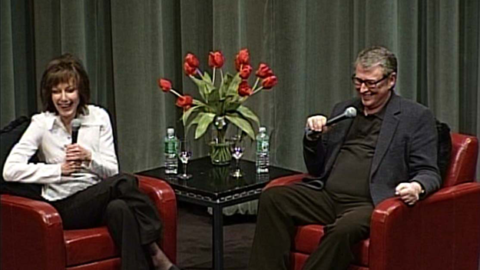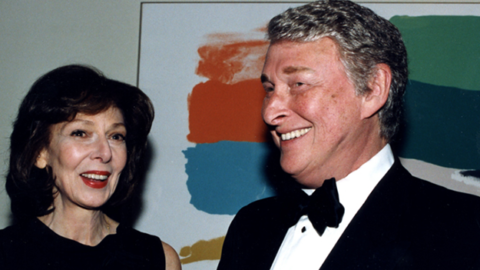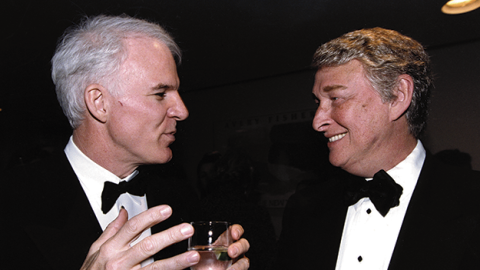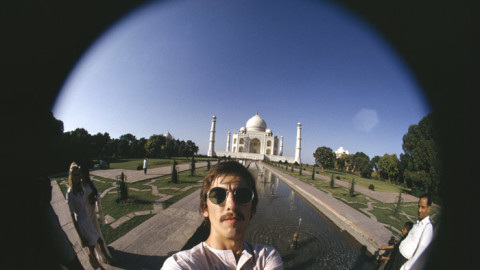Matters of Life and Death: Mike Nichols
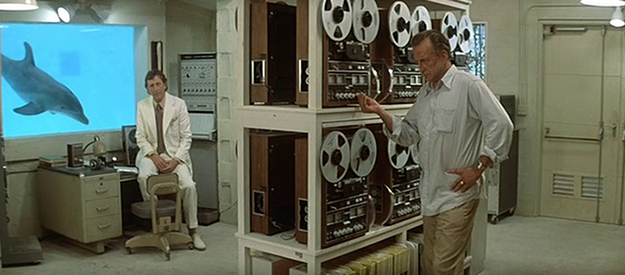
The Day of the Dolphin
A head appears in close-up, looking directly into camera, and lays out a theme, a landscape, a journey—or, to use the term that crops up often in Mike Nichols’s interviews, a “process”—for the film to follow. In The Day of the Dolphin (73), it’s marine biologist and dolphin specialist Dr. Jake Terrell (George C. Scott), who invites us to “Imagine. Imagine that your life is spent in an environment of total physical sensation. That every one of your senses has been heightened to a level that in a human being might only be described as ecstatic.”
In Wit (01), the head actually swings into view, an obstruction in front of the pleasantly out-of-focus blur through a window. This is another specialist, Dr. Kelekian (Christopher Lloyd), who presents us, and through us his patient Vivian Baring (Emma Thompson), with a less inviting prospect. “You have cancer. Stage 4 metastatic ovarian cancer.” As he goes on to explain, there is no stage 5. These are very direct opening gambits, a declaration of intent and meaning, and of the dramatic ground to be fought over. In a way, it’s a theatrical moment, the device of a director who began confronting audiences from a stage, first the existential peril of his improvisational routines with Elaine May and then with Neil Simon on Broadway.
But these theatrical moments become perfectly simple, stripped-down cinematic openers. These heads and faces, offering such unequivocal, complete statements, are already disquieting in the isolation of the screen. What they offer is a seduction (even if that’s for an eight-month course of chemotherapy), an offer to unfold a whole world that’s a cure for the ills of this one. Although in the end there may be nothing beyond the unfolding process. Vivian Bearing suffers chemotherapy, and brings her own academic specialty, study of the Holy Sonnets of John Donne, to bear on her condition, but neither proves a cure. Jake Terrell tries to make the dolphins’ world his own, but at the end is left on the edge of his island paradise while the image burns out to white—another favorite Nichols device, exiting the stage by dissolving the film.
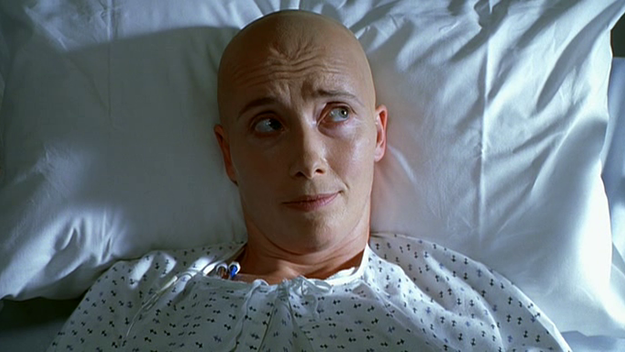
Wit
Only on film, of course, could these close-ups have had such face-to-face impact—so emphatic, reassuring and at the same time sowing a little seed of distrust (are they trying to sell us something?). But a change of function, of emphasis, can be seen taking place between Nichols’s earliest use of close-ups in his adaptation of Who’s Afraid of Virginia Woolf? (66), where they serve to give the right stresses and variation to Edward Albee’s dialogue, and their use in his later films. One of the major dueling thrusts in Virginia Woolf comes after a night-time excursion to a diner and the temporary dispatch of their guests have left George (Richard Burton) and Martha (Elizabeth Taylor) alone. Into an empty shot, George’s face first enters in profile, and then Martha’s, as they challenge each other to a final contest: “Total war?” “Total.”
Nichols retains a liking for the close-up profile, but subsequently lets it slide into view, an intruder (like Dr. Kelekian), but not a hostile or even particularly assertive one. What the intruder brings, his intentions, his meaning—unlike his image—for the moment is hidden from view. For one thing, the head shot may not be surrounded by a dark screen but by a whole landscape about to be unfolded, explored. An early scene in The Day of the Dolphin celebrates Terrell’s cross-species bonding with Alpha, prime specimen in his study of dolphins, as they swim and play together in an illuminated tank. This dissolves into a shot of the wide, mysterious ocean, from which Alpha came, before a head encroaches on it, that of Harold DeMilo (Fritz Weaver), director of the Franklin Foundation that is financing Terrell’s experiments.
Reasonable, soft-spoken, DeMilo is in conversation with someone who seems to be blackmailing him for access to Terrell’s island laboratory. In reverse angle shots of DeMilo, he is paired with a bust of Benjamin Franklin, as if to testify to the debasement of New World dreams and ideals. The Day of the Dolphin turns out to be a strange hybrid: a quasi-comic Seventies paranoia/conspiracy thriller, a conspiracy foiled in the end—Rin Tin Tin–fashion—by the dolphins, and a lyrical evocation of a faraway existence, a re-imagining of the possibilities of life. (“Beautiful,” exclaims DeMilo on a visit to the island. “It’s like being in another world.”)
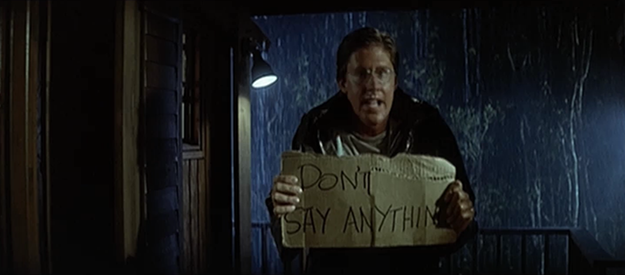
The Day of the Dolphin
The island of Pianosa, off the Tuscan coast of Italy, would count as faraway and even as a special world of its own (one online travel site claims that John Milton would have thought it was paradise found). It is the setting Joseph Heller chose for the US Army Air Force bomber group in Catch-22, which Nichols’s film version swapped for Guaymas, Mexico, as a location. This looks more desert than paradise—ringed by jagged mountains as barren as volcanic rock—but the film’s early scenes are an in-close, atmospheric tour of the terrain, and of the mechanics of launching bombing missions (as was the novel, as much a picture of the numbing realities of war as a burlesque satire of them).
There’s even a travel guide, of sorts. As one squadron prepares to take off, Richard Benjamin slides into profile close-up in the control tower: “Good afternoon, men, this is Major Danby, your Flight Operations Officer, welcoming you to today’s mission . . . Weather conditions have improved tremendously over the mainland. So you won’t have any trouble at all seeing the target. Of course, you mustn’t forget, that means that they will have no trouble at all seeing you.”
Catch-22 is usually counted as an epic misfire, the first film to punch a hole in Nichols’s charmed reputation. But it’s a wonderful picture of men in their landscape, which begins as lyrically, with as much sense of promise in a world newly discovered, as The Day of the Dolphin.
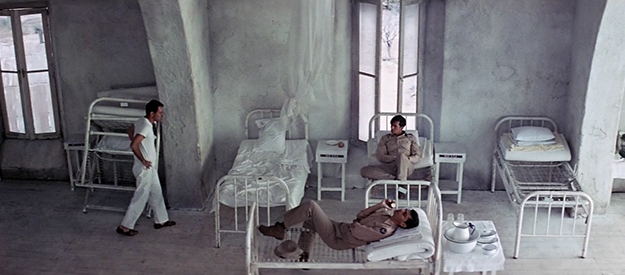
Catch-22
Out of the darkness behind the opening credits, as the sun rises, the shape of a land mass gradually emerges, across another body of water which suggests this might be an island (though it is presumably the coast of Guaymas). The only sounds are bird calls and the isolated barking of a dog—the film has no background score—until this world is abruptly submerged in the whirling dust and roaring engines of B-25s taxiing for takeoff. At the film’s end, reluctant/paranoid bombardier Yossarian (Alan Arkin) decides to flee the war by returning to the sea, launching a rubber dinghy in which he’ll paddle to Sweden. This looks like an escape, a rah-rah victory over the madness of war, but it also looks like those other Nichols endings where uplift plays like sarcasm. It’s as if escape is just another stage in the ongoing process, a kind of confirmation by rejection, like the flight from marriage into marriage of The Graduate (67) or fighting the corporation by advancing through it in Working Girl (88).
But war is not the only issue in Catch-22, or rather it is not the full context of the “craziness” from which all the characters suffer (or which they are accused of). That craziness is more like the human condition, and the ultimate catch-22 is that death is the only escape. War, and the military’s own local variant of catch-22—you can stop flying if you’ve gone crazy, but to want to stop is proof you’re not crazy, therefore you have to keep flying—just makes that final “escape” easier, and at worst compulsory.
The novel’s Yossarian finally sees that “Catch-22 did not exist . . . but it made no difference. What did matter was that everyone thought it existed.” Catch-22 is not a law, it’s just the state of things, as Yossarian observes during his wandering through a night of horrors in Rome (“What a lousy earth! . . . How many hearts were broken? How many suicides would take place that same night, how many people would go insane?”).
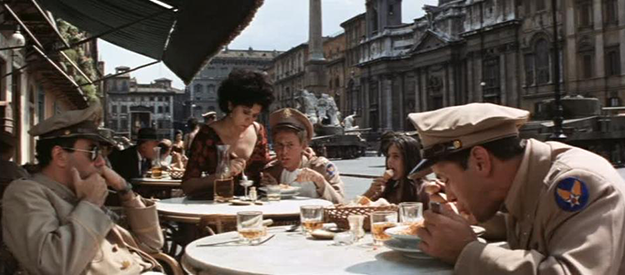
Catch-22
The film’s version of this is some Fellini-esque mini-tableaux rather than the carnival of human degradation, Hell’s catch-22, that Heller envisions. Which is not to say that Nichols’s Catch-22 is lacking in its own sense of carnival, in the way his films tend to picture the human condition, as something in evolution (like Jake Terrell’s cetacean dreaming in The Day of the Dolphin), or at least in passage from beginning to end.
The wonderful awakening of Catch-22’s credit sequence is followed by a death intimated in flashback (Yossarian tending to his plane’s stricken gunner, Snowden), with the flashbacks becoming steadily longer through the film, each ending in a white-out, the dissolve to nothingness, until the final revelation of Snowden’s insides spilling from his flying suit (Joseph Heller: “Here was God’s plenty… Man was matter, that was Snowden’s secret”).
The complement to this, its extension and distillation, is Wit, which watches death at work from first frame to last, and the attempt to explain, contain and come to terms with it. In retrospect, it is natural that Nichols should have taken on the medical saga of national proportions in Angels in America (03), which advertises its completeness with a credit sequence that flies in and out of the clouds to visit key cities from coast to coast. There’s completeness of a different—technical, stylistic—sort in Nichols’s use of long takes, including one sequence shot in Catch-22 that begins with Yossarian waking in hospital, chatting awkwardly with the self-effacing chaplain (Anthony Perkins), then watching two nurses tend to the “soldier in white” by switching the two bottles that first drip fluid into this totally plaster-encased patient and then drain it out (another life medically encapsulated).
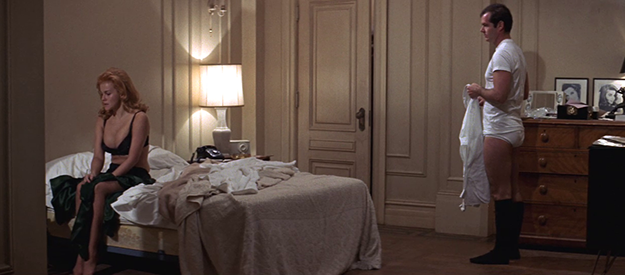
Carnal Knowledge
The extended take is distinctive, and ’scope framing adds to it in terms of a “whole environment” approach to a subject. This is unsurprising with the “spectacular” Day of the Dolphin and Catch-22, but it is surprising that the domestic ronde of Carnal Knowledge (71) should be shot in Panavision. This film’s opening is spectacular in its own way. Over the credits and a black screen, Jonathan (Jack Nicholson) and Sandy (Art Garfunkel) discuss their expectations of the opposite sex. Then Susan (Candice Bergen) walks out of the night directly towards the camera and is followed, in one long comprehensive movement, through the rooms where a college “mixer” is listlessly in progress, past Jonathan and Sandy lounging in a doorway, until Sandy sets about making a hesitant approach.
By the film’s end, Jonathan’s more aggressively sexist expectations have become his own cage, to which he gives the key, with exact instructions, to prostitute Louise (Rita Moreno). Does the width of the frame do something to describe the scope of the human condition, the passage, from beginning to end, of the relationships? In a similar opening in Heartburn (86)—this one just widescreen—Rachel (Meryl Streep) walks directly into shot beneath the archway of a church, as Mark (Jack Nicholson) walks in after her, blinking as he takes off his dark glasses, summing up a veiled relationship that has yet to begin its parting/reunion/parting cycle.
Strangely affecting is the opening credits sequence of Who’s Afraid of Virginia Woolf?, as George and Martha make their way home across campus at night, after a faculty party. They pass a large, brightly lit greenhouse complex, and everything that stirs around them—trees, the leaves on the path, Alex North’s wistful score, not unlike the romantic yet regretful way Georges Delerue introduces us to Dolphin Island—seems suggestive of other possibilities. Is it the buried life these individuals might have had, another destiny for their species? Already, with its dialogue yet to begin, the play has been given in microcosm, and Nichols has made the transition from his theatrical self to a cinematic one.
Mike Nichols: American Masters, directed by Elaine May, premieres tonight on PBS as the first night of the 30th-anniversary season of Thirteen’s American Masters series. A new Blu-ray/DVD edition of The Graduate, in a fresh 4k restoration, is available from Criterion Collection on February 23.
Richard Combs has most recently written on Rear Window and fairy tales for the Hitchcock Annual 19 and on Jafar Panahi for Cinema: Made in the Middle East & North Africa.



